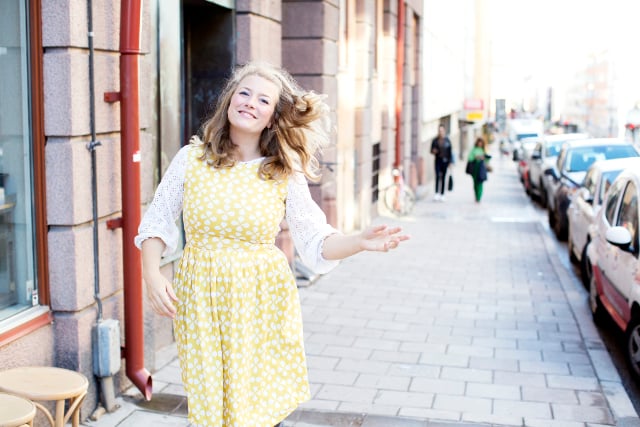First up is television presenter and blogger Elsa Billgren, 31, who started her popular fashion and lifestyle blog at Elle Sweden nine years ago, writing about all things vintage fashion, food and lifestyle.
She also runs a vintage wedding dress rental service, and currently spends time living between her homes in Stockholm and the island of Gotland.
Hi, Elsa! We love your blog and would be interested to know more about what made you want to start blogging initially – how did you get into it?
It all began when I worked at Beyond Retro as a PR Manager; one of my roles was to write the blog and I found that the most fun part of the job. I loved following trends, taking pictures for the articles and writing – generally being creative. The job involved working with journalists, leading me to meet a journalist at Elle magazine who often got in touch with me to help her out with vintage fashion content as I knew a lot about that topic. In 2008, vintage was a real up-and-coming thing – people didn't really know about second hand and sustainability, so what Elle was doing felt really new. They wanted to show a broad fashion spectrum and I was the only one really working with vintage fashion and also blogging at the time. They then asked if I would like to start a blog on the site and I jumped at the chance. It was the perfect fit.
Initially, I focused on writing about vintage clothing, but then started to branch out to write about my emotions and topics closer to my heart – for example, sharing the news when I met a guy, then writing about the experience of my flat burning down. It turned out that people were really interested in those moments in my life; it all went from there. It was love at first sight between me and my blog!
Your blog is somewhere lots of people go for fashion inspiration – where do you get your own inspiration from?
My inspiration has come from different places through the years – I find lots of inspiration from new people I meet, food, other people who adopt trends early on and have a very unique photo style. Instagram is a huge source of inspiration, looking at different photography styles and how to present enjoyable things in life – even simple things, like breakfast. One of the most amazing ways of being inspired is through contacting people you admire on Instagram and being able to meet up – then you have a new friend and colleague. I don't know very many other industries where you can do that, where everyone is so accessible.

What's your favourite thing about being a blogger?
What I love is the versatility of daily life – my days never look the same and I learn new things all the time. Of course, getting the right formula takes practice, but it's definitely never boring. It's a bit scary sometimes and often is time-consuming. You really do end up mixing your personal life with your business life, but I'm the daughter of two artists [Helene Billgren and Ernst Billgren], so I don't know what a 'normal' job looks like!
The most rewarding but also most frightening blog posts have been the most personal, the most honest. If you want to make it work, you have to let your readers see more than just the superficial topics, but it's key to meet the balance between being honest and being private, keeping control of your content but also being open with your readers. It's really useful to me to have dialogue with my followers – I have really smart readers who would never accept anything stupid from me… they're like my grandmother, keeping me in line!
Sounds like busy work! On the flip-side, what would you say is the most challenging thing about being a blogger?
Needing to reinvent yourself every day is challenging – you have to be very adaptable and follow the stream of what's interesting at the moment, while also being in touch with – and true to – yourself. You need to be a real chameleon, without losing your truth. My readers would know if I was doing something I didn't believe in.
Which topics have you found Swedish audiences most like to read about?
For my blog, it's my more personal posts which resonate the best and get the best response. Being honest and relatable makes the blog feel approachable – I can have moments of vulnerability too, and writing about topics close to my heart gives the blog a more human feel.
My followers also like the particularly visual posts, both on the blog and on Instagram – I put a lot of time into making sure the pictures are aspirational, because I want to inspire and show the beautiful things in life. I'd like for people to sit in their pyjamas drinking tea, reading my blog and feeling inspired to do something great today.
And finally, what advice would you give to aspiring influencers looking to follow in your footsteps?
I would advise anyone who wants to be a blogger or an influencer to approach bloggers they admire, to be friendly, to spend time dreaming up new ideas and to understand what your strengths are. For me, I know I'm knowledgeable about everything vintage and I'm a curvaceous girl who loves to be photographed – which is fairly atypical. I need to show how the clothes I buy look on my body – that's my niche, and everyone should find their own. Essentially, you need to ask yourself: who am I, from the outside and what can I offer? What's my unique quality?




 Please whitelist us to continue reading.
Please whitelist us to continue reading.